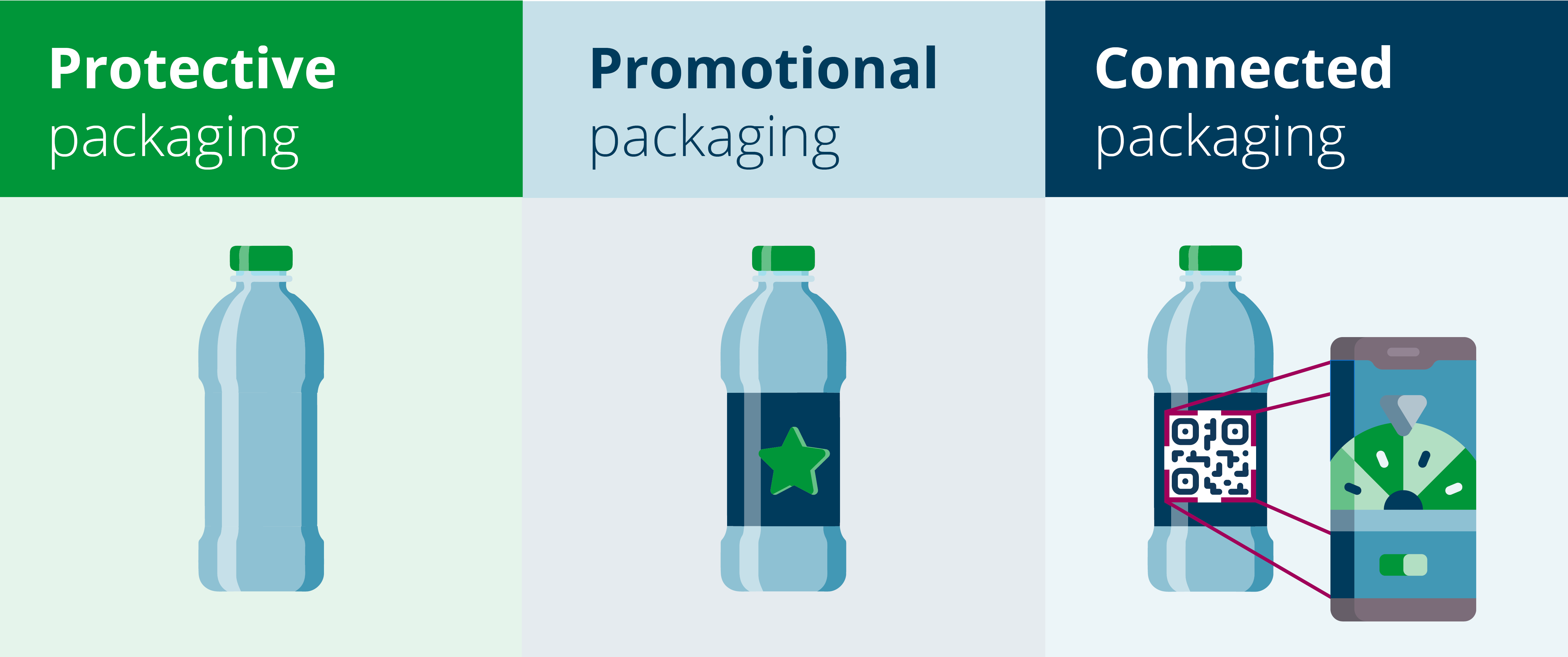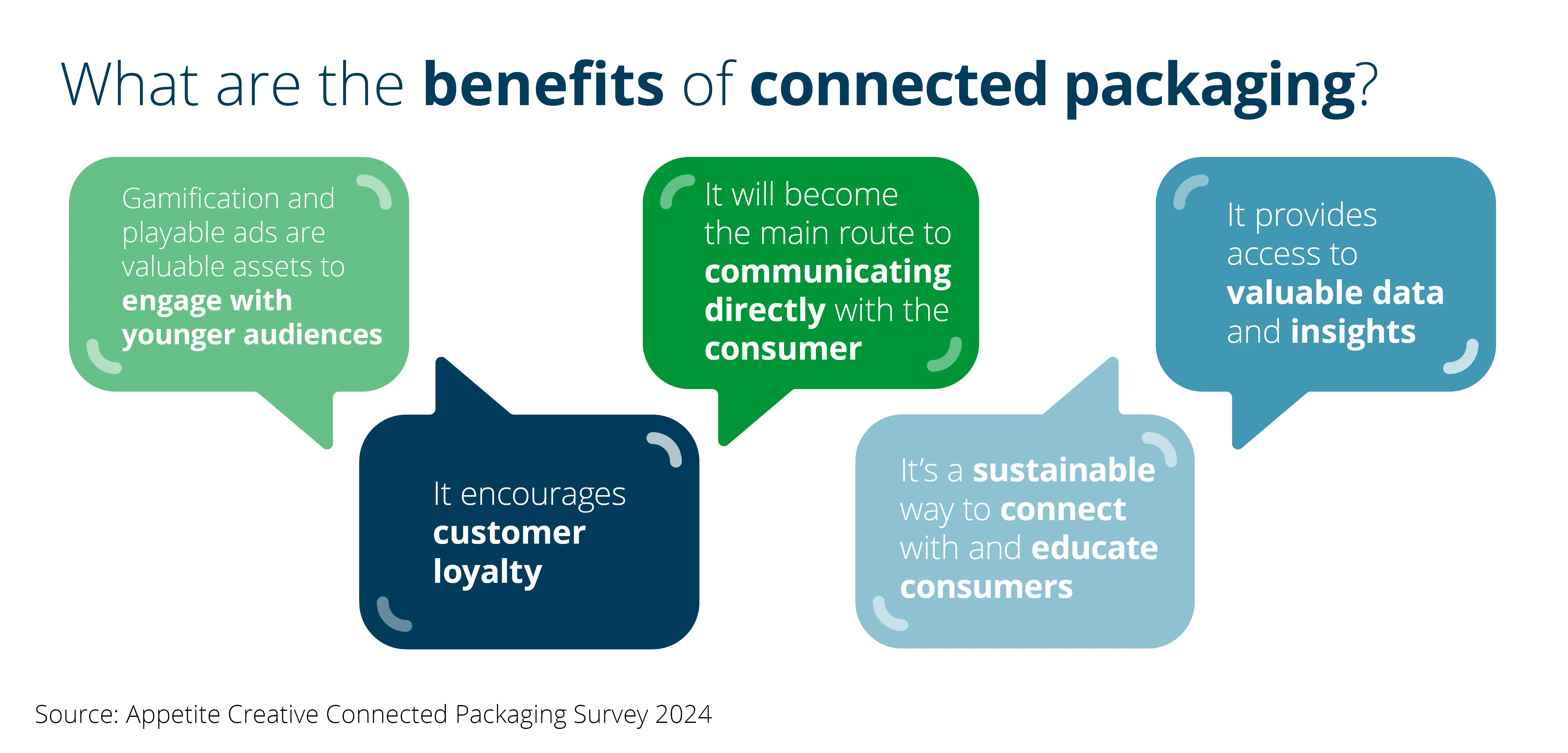Over the years, packaging has evolved from a plain product protector to the face of the brand. Now, thanks to connected packaging technologies, packaging is no longer “just a pretty face” but forms a key part of a brand’s storytelling.
In this blog, we delve into how packaging design has evolved to place consumer appeal front and centre, and how 100 years on, with technology at everyone’s fingertips, connected packaging features, such as QR codes, can take brand-consumer interaction to a new level.

Attracting and engaging consumers
Visual appeal is vital to capturing consumer attention beyond a loyal customer base. Beautiful packaging and labels with unique, eye-catching designs enhance shelf-appeal, inspiring consumers to take a closer look.
Stand-out homeware packaging designs might feature print matching the pattern of the tableware within, which is much too pretty to discard, while limited-edition packaging and labels – such as bottles with custom shrink wrap celebrating sports events – add a layer of exclusivity and collectability.
Novel packaging is often deliberately developed to excite consumers, prompting them to share a photo or even an unboxing video, to their social media accounts – offering free brand exposure, or, in the case of the Heinz Tattoo Stencil label, a way to express their die-hard devotion to the brand.
Packaging-based promotions have evolved to be more interactive than ever before. While the -inclusion of mail-away coupons and competitions on product packaging is nothing new – US cereal giants Kellogg’s and General Mills were running their first promotions more than 100 years ago – the objective remains the same: delighting consumers and fostering brand loyalty.
That said, with retail packaging traditionally focused on attracting attention to grow sales, communication between brand and consumer has typically been one-sided.
Connected packaging and QR codes
Connected packaging equipped with QR codes can help bridge the divide between the physical and the digital world, taking consumer experience to a new level. QR codes enable an instant connection between consumer and brand, providing consumer access to product information while allowing brands to capture consumer responses and feedback.
Consumers have become familiar with scanning QR codes in everyday situations in the past few years. Four in five smartphone users in the UK and Europe have scanned a QR code at least once, with one in three scanning at least one QR code per week (Martech Alliance).
In retail, the transition of packaging barcodes to standardised 2D codes powered by GS1 – previously known as the GS1 Digital Link – at the point of sale has begun, increasing brand leaders’ interest, and there has never been a better time to start exploring the technology.
Brands are discovering the versatile applications of QR codes, with Bitly’s QR Code Trends Report 2023 identifying consumer goods as the third fastest growing industry by number of scans – with an 88% year-on-year growth.
QR codes powered by GS1 are small, but they have the power to deliver information to multiple stakeholders via one convenient scan – providing valuable data and enhanced product traceability to brands and retailers while delivering helpful or engaging content to consumers – content that can change over time, without changing the packaging.
This is made possible by the standardised structure of the Uniform Resource Identifier (URI) represented by the QR code, which – in the simplest terms – is a website address that includes a sequence of identifiers and attributes that serve as gateways to information such as expiry dates, serial numbers, and batch/lot numbers, as well as landing pages.
Depending on what device or app is used to read the code, certain identifiers are processed to provide access to a specific data source. This means that a mobile phone camera scan might open a landing page presenting information regarding recycling and sustainability to consumers, while brands and retailers using an EPOS scanner might gain access to supply chain tracking and expiry dates to inform dynamic pricing strategies.
Connected packaging: a win-win for brands and consumers
Packaging is the final touchpoint between consumer and brand – where consumers expect to find everything they need to know about the product, from allergens and nutrition to usage and recycling instructions – but also the last opportunity for brands to make a lasting connection with the consumer.
With customer retention considered easier than gaining new customers, packaging QR codes allow brands to drive app downloads and sign-ups to loyalty programmes and online communities. Members are rewarded with access to exclusive content, discounts, freebies, and events. In return, brands gain a captive audience for cross-promotion of other products and competitions, as well as compliant personal data for use in targeted promotional campaigns.
Competitions and games are popular, and joining one of the games commonly promoted by QR codes on soft drink labels or snack packaging is easy. Since 2019, the recurring What the Fanta? campaign sees QR codes on bottles and cans used to access clues about the mystery flavour. Engagement and consumption have soared: sales of the 2021 mystery flavour beat Fanta Orange sales by almost half.
In addition to providing entertainment, scannable QR codes can transform time-consuming, mundane tasks such as locating manuals and ordering consumables. Such codes help brands deliver a more convenient consumer experience, thus enhancing brand loyalty. The addition of variable data elements, such as a batch or serial numbers, enables the content served to change over time: the first scan could open a landing page to provide model-specific assembly, installation, or user videos, while subsequent scans could provide content to assist with consumable ordering or warranty information.
The ability to track consumer interaction with codes over time provides enhanced consumer insights and has been identified as a potential replacement for third-party data that could make up for the loss of tracking cookies.
Considering potential returns like this, it is not surprising that connected packaging is high on brands’ priority lists, with 80% of respondents of Domino and Appetite Creative’s Connected Packaging Survey 2024 citing that connected packaging will be increasingly important to the packaging industry in the next 12 months.

Digital printing and connected packaging
Forward-thinking brands are using QR codes to create immersive, interactive experiences to enhance interactions with consumers, as well as adopting GS1 technologies to future-proof their business. Providing information for multiple stakeholders via one compact code allows brands to focus label and packaging designs on maximising consumer appeal and driving scans.
Digital packaging and label print can be excellent enablers for consumer engagement campaigns, as they not only make the production of eye-catching, variable designs with limited runs faster and more affordable but also allow for the inclusion of variable QR codes for consumer engagement. Brands can incorporate QR codes into packaging designs as part of a digital or hybrid printing process. Even near-line packaging customisation with variable data print and QR codes via a digital inkjet print bar is possible.
A growing number of companies offer services to assist brands in harnessing the power of connected packaging. As an expert in variable data print, Domino is a great partner to explore the potential.
Learn more about how Domino can help you seize the connected packaging and QR code opportunity at https://www.domino-printing.com/en/solutions/2d-codes.